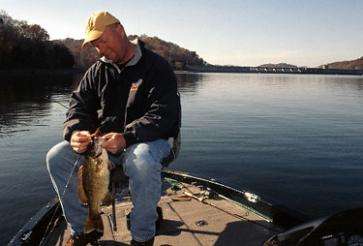
Most of the year, you’ll find me throwing baits that are designed to imitate a shad, crawfish or maybe an alewife. But there’s one time of year that I’ll always have at least one bait ready to go that resembles a bluegill, and that time is now.
During the spawning season — from prespawn right through the spawn and on into the postspawn — few bait colors will draw the attention or the ire that bluegill colors will get from smallmouth bass. The reason is simple. Bluegill are a threat to the eggs and fry of a smallmouth, and smallmouth won’t tolerate that.
Everyone seems to know that bluegill are a threat to largemouth nests. You can see it. Since largemouth spawn so shallow — usually in just a foot or two of water unless it’s exceptionally clear — the whole process is there for you to watch. I’ve stood on pond banks and in my boat watching bluegill pester and annoy largemouth until they just couldn’t take it anymore. They’d run the bluegill off time and again, but the bluegill would stay after it until one of them got absolutely slammed by the largemouth.
Well, the same thing happens with smallmouth bass. We just don’t get to see it very often because smallies spawn so deep. In fact, smallmouth spawn so very deep that I almost never bed fish — at least not like the largemouth guys do it. You won’t find me anchoring my boat, staring into the depths and repeatedly casting to a single smallmouth that I find on a bed. It just doesn’t work as well with smallmouth.
But that doesn’t mean I don’t want to take advantage of those same instincts and tendencies when fishing for smallmouth during the spawn that you know work on largemouth. And part of that involves using baits that trigger those instincts.
One of my favorite baits at this time of year is a spinnerbait that we make right here at Punisher Lures. I usually use a 1/2- or 3/4-ounce model in a color pattern we call “green pumpkin red.” What it really looks like in the water is a bluegill.
Have you ever really studied a bluegill in the water? To me anyway, they have a lot of green pumpkin and chartreuse in them. I’ll take one of our green pumpkin red spinnerbait skirts and a chartreuse dye marker and color up the very tips of the skirts with the chartreuse dye to create a pretty realistic bluegill pattern. The blade colors I choose depend upon water clarity. If the water’s really clear, I’ll use silver. If it’s dingy or dirty, I’ll use gold. Willowleaf blades will help keep the lure down where you want it. Colorado blades have too much “lift” for this technique.
I’ll cast my spinnerbait out where I expect there are some spawning smallmouth and let it sink all the way to the bottom, then crank it back just fast enough to keep the blades spinning. This is the old “slow rolling” technique that largemouth fishermen use in the prespawn, and it works for smallmouth, too.
My goal is to put that lure in front of some of those spawners and get them to think it’s some kind of crazy bluegill on steroids that’s come to raid their nests. I always use a trailer hook with this technique because when the bass hit it, they usually aren’t trying to eat it. They just want to kill it or scare it away, and that trailer hook can easily mean the difference between a bunch of fish in the boat and just a bunch of vicious strikes.
Give that bluegill spinnerbait technique a try when your smallies are spawning, and I think you’ll see why I love it so much.
Until next time, if you have any questions or comments, I’d love to hear from you. Please e-mail me atStephen@thesmallmouthguru.com.





